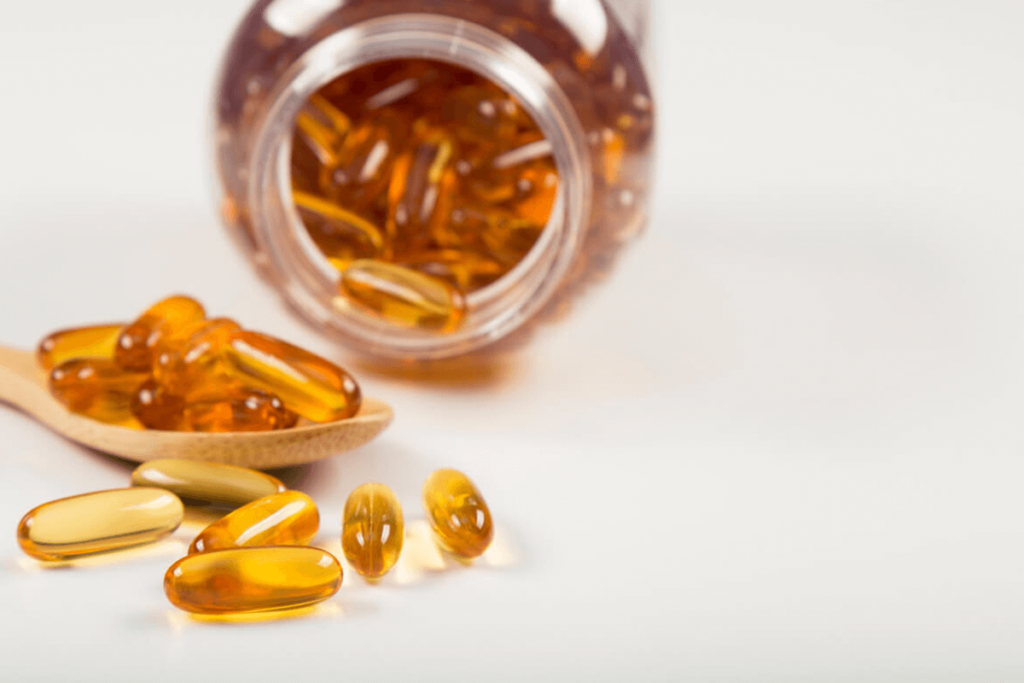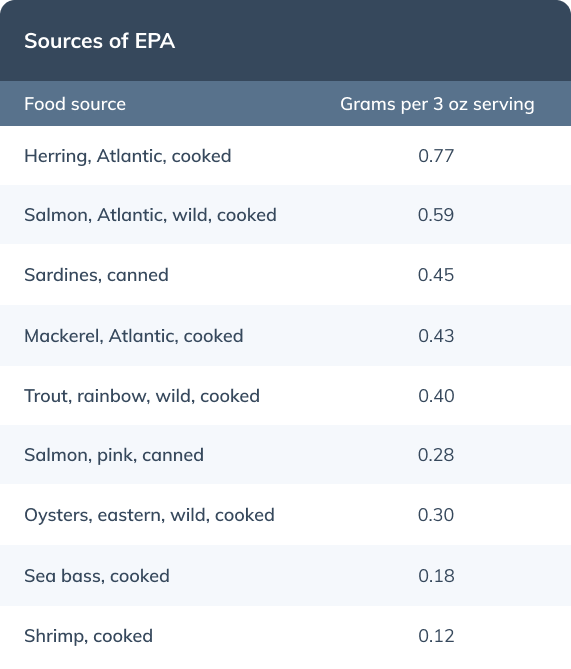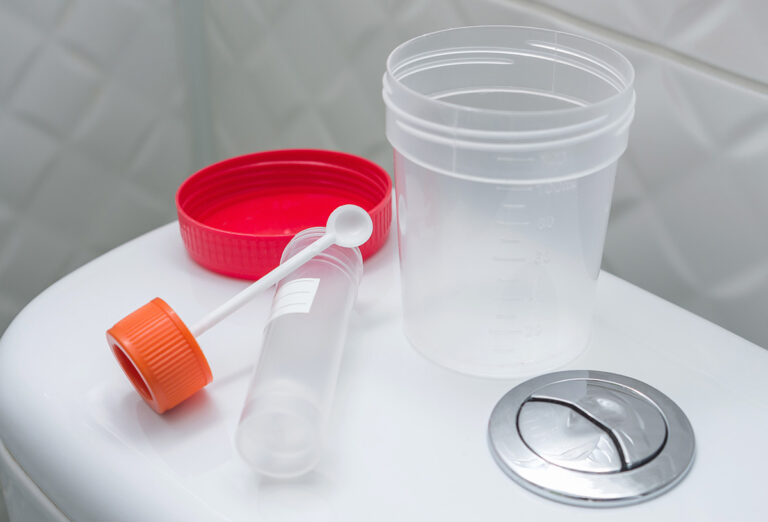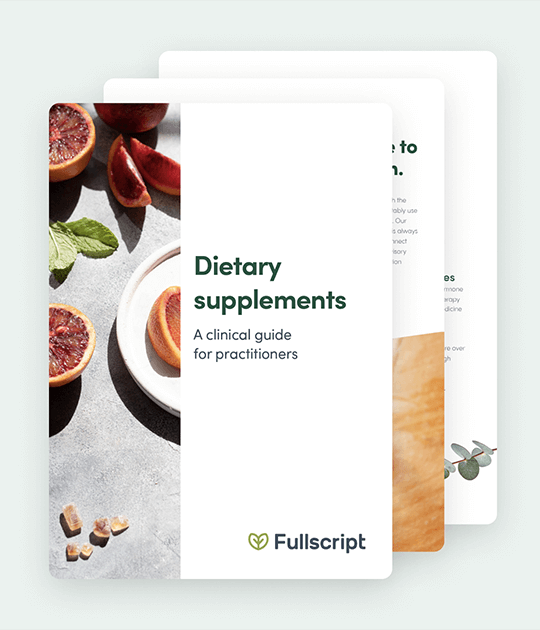There are three types of omega-3 fatty acids: EPA (eicosapentaenoic acid) and DHA (docosahexaenoic acid), which are found in cold-water fish, and ALA (alpha-linolenic acid), which is found in plants like flax, hemp seeds, chia seeds, and walnuts. The benefits of omega-3 fatty acids are impressive. Specifically, EPA may positively affect cardiovascular disease risk factors, symptoms of depression, menopause, and rheumatoid arthritis. (4)(8)(11)(15)

Ready to start delivering better patient care?

What is Eicosapentaenoic Acid (EPA)?
EPA is a polyunsaturated essential fatty acid. This essential fatty acid metabolism acts as a precursor to important lipids (fats) known as prostaglandins. Prostaglandins control critical processes such as inflammation, blood flow, and blood clot formation. EPA can be found in cold-water fatty fish and seafood. (2) The following table outlines how many grams of EPA per three ounce serving is found in different food sources that contain EPA:

4 important health benefits of EPA
While many studies involving fish oil focus on the benefits of either DHA or a combination of DHA and EPA, EPA on its own offers some very impressive health benefits.
1. Lowers risk of cardiovascular disease
Although the American Heart Association promotes eating fish for better overall heart health, studies show that the EPA in fish oil supplements can help lower several important cardiovascular risk factors, including arterial calcification, high blood pressure, and elevated triglycerides.
Preliminary animal research suggests that EPA helps prevent the buildup of calcium deposits in arteries. (6)(12) The accumulation of calcium can narrow arteries and reduce blood flow. Clinical studies show that a daily dose of EPA also decreases systolic blood pressure (the top number in a blood pressure reading) as much as 8.7%. (4)
However, the biggest impact from EPA is its ability to lower triglycerides. Triglycerides are a type of fat found in the blood that is directly linked to the food you eat. When you eat, your body converts excess calories into triglycerides and tucks them away in your fat cells for later use. Over time, however, high triglyceride levels can contribute to the hardening of the arteries (arteriosclerosis) and acute pancreatitis. (7) One randomized clinical trial found that daily supplementation of EPA for 12 weeks reduced triglycerides by 19.7% to 33.1%. (5)

2. Reduces symptoms of depression
Depression rates are substantially lower in countries where diets are high in fish. (10) Studies suggest that these mood-boosting effects may be attributed to EPA, not DHA. In one meta-analysis of 28 clinical trials, it was suggested that EPA could be more efficacious than DHA in treating depression. (9) Another meta-analysis of 15 randomized trials concluded that fish oil supplements containing at least 60% EPA could effectively reduce symptoms of primary depression. (15)
3. Eases symptoms of menopause
While EPA’s depression-soothing properties may help women with low moods that can occur during menopause, this fatty acid’s real value lies in its ability to reduce the frequency of hot flashes. Hot flashes and night sweats affect up to 75% of all women during perimenopause. They come on suddenly and can last for up to 10 minutes, affecting a woman’s quality of life. (3) In one eight-week clinical trial published in the journal Menopause found that while EPA didn’t impact the intensity, it reduced the average number of hot flashes from 2.8 per day to just 1.58 per day. (8)

4. Slows the progression of rheumatoid arthritis
This chronic inflammatory autoimmune disease affects the joints and can lead to joint deformity over time. Although there is no cure, adopting an anti-inflammatory lifestyle may help reduce symptoms and slow the progression of the disease. Animal research in the journal Arthritis Research & Therapy found that EPA, combined with DHA, reduces several markers of inflammation, including interleukin 17A (IL-17A), IL-1ß, IL-6, and tumor necrosis factor-α (TNFα). (11)
The bottom line
EPA is predominantly found in cold-water fish. EPA may positively affect symptoms of menopause, depression, and rheumatoid arthritis, and reduce the risks associated with cardiovascular disease. Fish oil supplements contain omega-3 fatty acids including EPA. Speak with your healthcare practitioner before taking dietary supplements that contains EPA.
- Eating fish twice a week reduces heart stroke risk. (2018). Www.Heart.Org. https://www.heart.org/en/news/2018/05/25/eating-fish-twice-a-week-reduces-heart-stroke-risk
- Eicosapentaenoic acid (EPA). (n.d.). Mount Sinai Health System. https://www.mountsinai.org/health-library/supplement/eicosapentaenoic-acid-epa
- Hot flashes, sexual side effects of menopause | the north american menopause society, NAMS. (n.d.). The North American Menopause Society. http://www.menopause.org/for-women/sexual-health-menopause-online/causes-of-sexual-problems/hot-flashes
- Iketani, T., Takazawa, K., & Yamashina, A. (2013). Effect of eicosapentaenoic acid on central systolic blood pressure. Prostaglandins, Leukotrienes and Essential Fatty Acids, 88(2), 191–195.
- Jacobson, T. A. (2012). A new pure ω-3 eicosapentaenoic acid ethyl ester (AMR101) for the management of hypertriglyceridemia: the MARINE trial. Expert Review of Cardiovascular Therapy, 10(6), 687–695.
- Kanai, S., Uto, K., Honda, K., Hagiwara, N., & Oda, H. (2011). Eicosapentaenoic acid reduces warfarin-induced arterial calcification in rats. Atherosclerosis, 215(1), 43–51.
- Laufs, U., Parhofer, K. G., Ginsberg, H. N., & Hegele, R. A. (2019). Clinical review on triglycerides. European Heart Journal, 41(1), 99–109c.
- Lucas, M., Asselin, G., Mérette, C., Poulin, M. J., & Dodin, S. (2009). Effects of ethyl-eicosapentaenoic acid omega-3 fatty acid supplementation on hot flashes and quality of life among middle-aged women. Menopause, 16(2), 357–366.
- Martins, J. G. (2009). EPA but not DHA appears to be responsible for the efficacy of omega-3 long chain polyunsaturated fatty acid supplementation in depression: Evidence from a meta-Analysis of randomized controlled trials. Journal of the American College of Nutrition, 28(5), 525–542.
- Mischoulon, D., MD PhD. (2020). Omega-3 fatty acids for mood disorders. Harvard Health. https://www.health.harvard.edu/blog/omega-3-fatty-acids-for-mood-disorders-2018080314414
- Morin, C., Blier, P. U., & Fortin, S. (2015). Eicosapentaenoic acid and docosapentaenoic acid monoglycerides are more potent than docosahexaenoic acid monoglyceride to resolve inflammation in a rheumatoid arthritis model. Arthritis Research & Therapy, 17(1).
- Nakamura, K., Miura, D., Saito, Y., Yunoki, K., Koyama, Y., Satoh, M., Kondo, M., Osawa, K., Hatipoglu, O. F., Miyoshi, T., Yoshida, M., Morita, H., & Ito, H. (2017). Eicosapentaenoic acid prevents arterial calcification in klotho mutant mice. PLOS ONE, 12(8), e0181009.
- Omega-3 fatty acids. (2021). National Institutes of Health. https://ods.od.nih.gov/factsheets/Omega3FattyAcids-HealthProfessional/
- Rimm, E. B., Appel, L. J., Chiuve, S. E., Djoussé, L., Engler, M. B., Kris-Etherton, P. M., Mozaffarian, D., Siscovick, D. S., & Lichtenstein, A. H. (2018). Seafood Long-Chain n-3 polyunsaturated fatty acids and cardiovascular disease: A science advisory from the american heart association. Circulation, 138(1).
- Sublette, M. E., Ellis, S. P., Geant, A. L., & Mann, J. J. (2011). Meta-Analysis of the effects of eicosapentaenoic acid (EPA) in clinical trials in depression. The Journal of Clinical Psychiatry, 72(12), 1577–1584.






